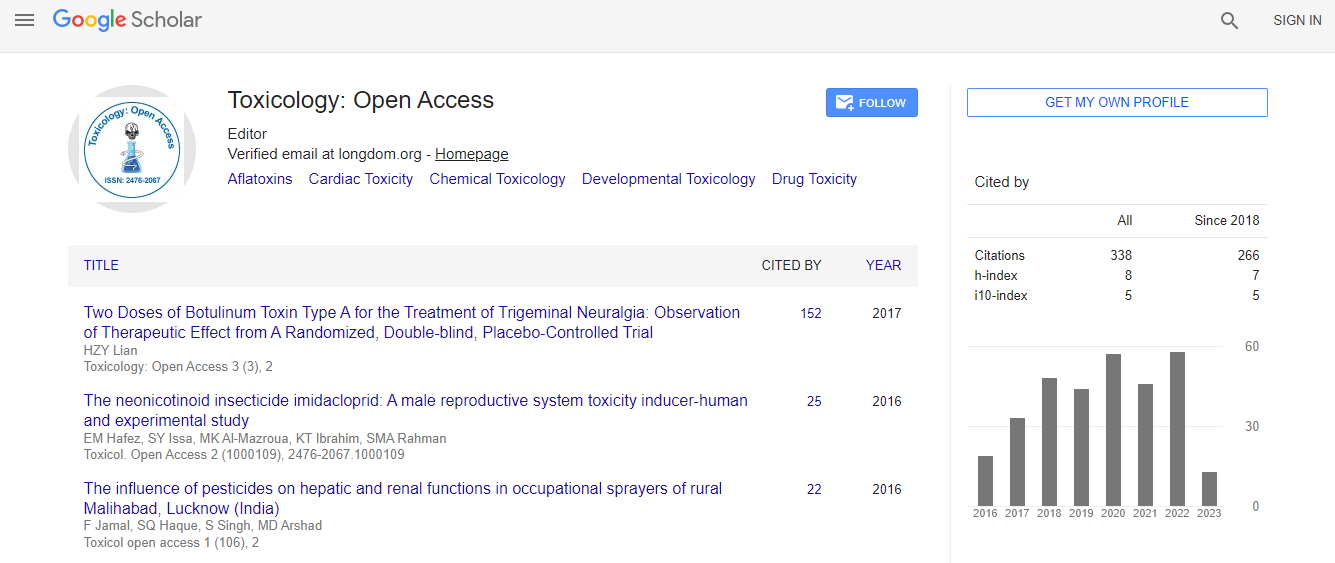Our Group organises 3000+ Global Conferenceseries Events every year across USA, Europe & Asia with support from 1000 more scientific Societies and Publishes 700+ Open Access Journals which contains over 50000 eminent personalities, reputed scientists as editorial board members.
Open Access Journals gaining more Readers and Citations
700 Journals and 15,000,000 Readers Each Journal is getting 25,000+ Readers
Google Scholar citation report
Citations : 336
Toxicology: Open Access received 336 citations as per Google Scholar report
Indexed In
- Google Scholar
- RefSeek
- Hamdard University
- EBSCO A-Z
- Geneva Foundation for Medical Education and Research
- Euro Pub
- ICMJE
Useful Links
Related Subjects
Share This Page
Microbial bioactive compound for food preservation with antioxidant
14th World Congress on Toxicology and Pharmacology
Regina Mary R
Auxilium College, India
Keynote: Toxicol Open Access
Abstract
Food safety is a global issue with significant implications for human health. The World Health Organization reports that, annually, unsafe food results in the illnesses of at least 2 billion people worldwide and can be deadly. Some countries have made great progress in controlling foodborne diseases, but the number of those affected by foodborne diseases is growing globally. Foodborne disease is a global issue with significant impact on human health. With the growing consumer demand for natural preservatives to replace chemical compounds, plant and microbial antimicrobial compounds must be thoroughly investigated for their potential to serve as bio-preservatives. Our research focuses the microbial-derived products as antimicrobial agents for use in food preservation and to control foodborne pathogens in foods. Structure, modes of action, stability and resistance to these plant compounds will be discussed as well as their application in food industries and possible technologies by which they can be delivered. Benefits as well as challenges, such as the need for further research for implementation and governmental regulation, will be highlighted. Thermal processing is a common method of destroying vegetative microorganisms to ensure food safety, but this technique may cause undesirable nutritional and quality effects. Preservatives are commonly used to reduce the risk of foodborne illnesses. Increasing regulatory restrictions and consumer negative response to chemical compounds and to the use of antibiotics in agriculture have contributed to the pressure for the development of alternative compounds for use as antimicrobial agents. Antimicrobial agents have been predominantly isolated from bacteria and fungi and either produced through fermentation. Worldwide, spending on antiinfective agents has increased in recent years due to the limited effective lifespan of antibiotics as new resistant microbes emerge. New sources, including microbial bioactive molecules, must be thoroughly investigated for identification of novel antimicrobial compounds. Prodigiosin is a natural red colored bacterial secondary metabolite, widely used in pharmacological and biological applications. This investigation focused on nutraceutical and food functionalization potential of natural colorant PG. The antioxidant potential of PG was examined by DPPH and ABTS radical scavenging method. The bactericidal efficiency of PG was analyzed against six foodborne pathogens. The food Shelf life extant ability of PG was analyzed using meat extract powder as a model food material. The PG (70.19 g/kg) was biosynthesized from Serratia marcescens by solid state fermentation. The scavenging activity of PG was calculated to be 99% and 99.9% were DPPH and ABTS, respectively. The bactericidal efficiency of PG against the selected foodborne pathogens exhibited significant inhibition on growth than the synthetic colorant and the shelf life of the food was extended in the presence of PG containing food model. Hence, the PG may be used as food colorant and thus significantly reduce the addition of synthetic colorant in food processing industry. This study will bring an innovative approach on food additive for safe and sustainable food process. Because of variation in stability and efficacy to various food processing parameters and food systems, it is critical that natural prodigiosin be selected and delivered so that they are active against potential pathogens in particular food and are stable throughout the food√ʬ?¬?s shelf life. Effects of natural prodigiosin in Regina combination with other compounds or techniques must be more thoroughly investigated. Prodigiosin is active against Grampositive bacteria and fungi. Given the consumer demand for more natural products and the growing need for alternative preservatives to ensure food safety, it is imperative that natural bioactive prodigiosin be fully assessed for their feasibility for food application. This new field of research has great potential for more evaluation to meet regulatory requirements and to fully elucidate the possibility of employing antimicrobials from the extensive source of microbial worldwide. Recent Publications 1. Arivizhivendhan K V, Mahesh M, Boopathy R, Patchaimurugan K, Regina Mary R, Sekaran G (2016) Synthesis of surface modified iron oxides for the solvent free recovery of bacterial bioactive compound, prodigiosin and its algicidal activity. The Journal of physical Chemistry B; 120(36): 9685-9696. 2. Arivizhivendhan K V, Mahesh M, Boopathy R, Regina Mary R, Sekaran G (2016) A novel method for the extraction of prodigiosin from bacterial fermenter integrated with sequential batch extraction reactor using magnetic iron oxide. Process biochemistry; 51(10): 1731-1737Biography
Regina Mary R has her expertise in the field of development of bioactive compounds from microorganism for the biomedical application. Her contribution towards preparation of surface modification and bioactive compound conjugated nanoparticle for the treatment of pathogens from water and food system with a molecular mechanistic explanation. She has built this model after years of experience in research, evaluation, teaching and administration both in education institutions.
Email:febi.regi31@gmail.com

 Spanish
Spanish  Chinese
Chinese  Russian
Russian  German
German  French
French  Japanese
Japanese  Portuguese
Portuguese  Hindi
Hindi 